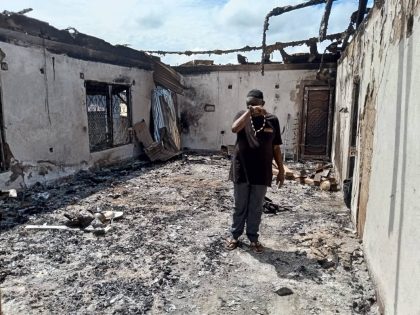Who’s Been Sleeping in My House
On prime time television in South Africa, the country is often a place without a past.

Image: Sean Jacobs.
South African television is fascinating. Every evening, as part of an ongoing anthropological investigation into the workings of the South African national consciousness, I take my dinner with an episode of 7de Laan (7th Avenue), a popular Afrikaans soap opera. The show is captivating in that it models a post-apartheid world around an expansive consumerist imaginary. So, the characters are often caught up in wondering about “spectacular” and “fantastic” materialist futures, about dream homes, parties and events, about eating and drinking and making merry, the exercises of consumption that hold the Laan together. As an elaborate fantasy of a conservative, white Afrikaans speaking audience, 7de Laan presents the quintessential ‘rainbow nation’ at work. It is a place without AIDS, homosexuality, bloody violence or rape. It is a place of cake and tea and of old fashioned family values. More importantly, it is a place without a past.
In the world of reality TV, the archaeologist Adam Ford has been exploring the place of the past all across Australia in the show Who’s Been Sleeping In My House? Over two seasons Ford has approached a number of families in a quest to unearth the hidden stories of their homes. In digging up the histories of these homes, he has found a great many things, including, “the bizarre story of a fugitive British MP who allegedly hid out in a Victorian family attic; a clandestine Nazi radio station that was suspected of broadcasting wartime secrets from the suburbs of Adelaide; a mysterious spy who was reportedly captured while on reconnaissance in the hills of Perth”. All over Australia, homes held fascinating secrets about the past. Who’s Been Sleeping in My House brings attention to the idea of the family home as a material locus anchoring versions of the past significant for collective society.
The show also allows us to try imagine the possibilities of similar forms of reality television in the post-apartheid present. We could, for example, speculate about whether a show like Who’s Been Sleeping in My House could pilot in South Africa? And what such a program would offer South African audiences? More importantly, we can wonder about the kinds of metaphors it enables for the interpretation of the South African past. For the producers of South African reality TV, I imagine, a show like this probably cuts too close to South African sensitivities about the past, and the related series of notions about property, ownership, dispossession, denial and racist exploitation to be of any commercial value. To dig into the foundations of the home is therefore not simply about unearthing exciting entertainment narratives. It is to ask difficult questions that unsettle the foundations of society.
Exploring domestic archaeologies can, however, also be a therapeutic, dignified enterprise. In Germany, for example, the conceptual artist Gunter Demnig has embarked on a campaign to unearth the broken, bitter histories of homes across Europe where Jews and other persecuted minorities were forcefully evicted and deported for execution, marking these sites with commemorative brass plaques. Inscribed with the names of these forgotten former residents, their date’s of birth, eviction and deportation, the Stolpersteine are commemorative stumbling blocks, mnemonic markers that stand in the way of modes of forgetting that often accompany the forging new collective futures.
Anchored into homes all across South Africa like 7de Laan, a fictional show like Who’s Been Sleeping in My House could create a similar opportunity to critically explore difficult aspects of the urban past. Handled carefully, such a show could undermine the superficiality of ventures such as the name your hood campaign by raising public awareness about forced removals, sites like Prestwich Place, and the bones buried beneath luxury homes built near Cape Town’s foreshore. Indeed, with little stretch of the imagination, we could even picture Gunter Demnig, the historical adventurer, making a cameo, perhaps even placing a commemorative Stolperstein, not to remind us about the domestic tragedies we’ve forgotten, but as a reminder that we should never forget.



















